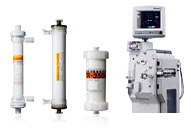ABO- / HLA-incompatible kidney transplantation / Antibody-mediated rejection (AMR)
ABO- / HLA-incompatible kidney transplantation is often accompanied by irreversible hyperacute rejection. In the 1980s, it was confirmed that with plasmapheresis the grafted kidney can adapt without causing hyperacute rejection, allowing ABO- / HLA-incompatible kidney donation for transplantation. Currently, double filtration plasmapheresis (DFPP) or plasma exchange (PE) is generally performed before and after renal transplantation to lower antibody titers by removing antibodies.
Acute hepatic failure
Acute hepatic failure is the sudden destruction of hepatic cells in individuals with no history of hepatic disease. The harmful substance ammonia cannot be metabolized to urea, the plasma ammonia concentration increases, and hepatic coma results. Similarly, bile cannot be excreted, the bilirubin concentration increases, and jaundice and other symptoms related to liver failure occur. In addition to nutritional management, CRRT or plasmapheresis is performed to support the patient until liver function is recovered.
Acute renal failure
Renal failure is a state of impaired renal function with various etiologies. Waste and fluid that are normally excreted accumulate in the blood, and uremic symptoms occur with progression. Acute renal failure is a sudden loss of renal function, triggered by renal disease or other factors. Waste products, such as urea and creatinine, rapidly accumulate in the blood. Continuous renal replacement therapy (CRRT) is performed to remove excess waste and fluid in parallel with treatment of the underlying disease.
Age-related macular degeneration(AMD)
In the field of ophthalmology, double filtration plasmapheresis (DFPP) is performed for the treatment of dry age-related macular degeneration (AMD). AMD occurs in two forms: the exudative "wet" form accompanied by choroidal neovascularization; and the nonexudative "dry" form involving drusen, geographic atrophy, etc. The nonexudative form accounts for 80-90% of all AMD cases in the USA. No effective therapy has been established for maintaining or improving vision in dry AMD. A retinal microcirculatory disorder is suspected to cause dry AMD. Recently, however, several studies have confirmed the effectiveness of DFPP in dry AMD treatment.
ANCA-associated glomerulonephritis
Anti-glomerular basement membrane disease
Arteriosclerosis obliterans (ASO)
Arteriosclerosis obliterans (ASO) is a pathologic chronic blood flow disturbance caused by arteriosclerosis in the aorta abdominalis and lower limb arteries. As the blood pools in the lower limbs, the patient experiences coldness and numbness in the toes, with dysbasia. If untreated, patients with ASO can develop necrosis of the toes and in extreme cases must undergo amputation of the lower limb. Other complications of ASO include ischemic heart disease (e.g., angina pectoris and myocardial infarction) and cerebrovascular events (e.g., stroke).
The treatment is medical therapy or surgical intervention, depending on symptom progression. When medication does not lead to sufficient improvement and surgical options are difficult to perform, DFPP is used to remove factors causing arteriosclerosis (e.g., LDL cholesterol).
Chronic hepatitis C
Chronic hepatitis C is caused by hepatitis C virus infection that produces liver inflammation for more than 6 months, resulting in cell destruction. In the early stage, few symptoms are observed, but if left untreated, the infection is likely to develop into cirrhosis and hepatoma over a prolonged course. Although in some cases chronic hepatitis C remains a mild form of hepatitis, approximately 70% of patients have progressive symptoms and approximately 30-40% of those develop cirrhosis and subsequently hepatoma. Cirrhosis not only carries the risk of hepatoma but also increases the likelihood of life-threatening complications including rupture of esophageal varices and hepatic encephalopathy.
There are two therapies for chronic hepatitis C: 1) therapy aimed at cure of the infection by eliminating hepatitis C virus from the body; and 2) symptomatic therapy to prevent progression to chronic hepatitis C by improving liver function. If cirrhosis and hepatoma develop, liver transplantation is performed.
Chronic inflammatory demyelinating polyneuropathy(CIDP)
Chronic inflammatory demyelinating polyneuropathy (CIDP) is a neurologic disease characterized by progressive weakness and impaired sensory function of the extremities. CIDP is thought to occur due to immunologic abnormalities. Treatment includes corticosteroids prescribed alone or in combination with immunosuppressants, plasmapheresis, and IVIg.
Cryoglobulinemia
Cryoglobulin is an abnormal antibody produced by plasma cells which precipitates at low temperature and redissolves at 37 degrees C. Cryoglobulinemia is a pathologil state when cryoglobulin is present in the blood. Cryoglobulin precipitation causes inflammation of blood vessels, resulting in symptoms including bruising, joint pain, and weakness. Patients may become hypersensitive to cold and show Raynaud's phenomenon, characterized by severe pain and cold urticaria of the extremities. Many patients have underlying diseases such as macroglobulinemia, cancer, autoimmune disease, and hepatitis C virus infection.
Steroids or immunosuppressants are administered, and DFPP or PE is performed to reduce cryoglobulin levels.
Please feel free to send us any questions you may have about our products and support.
Share your feelings and experiences when using our products.





